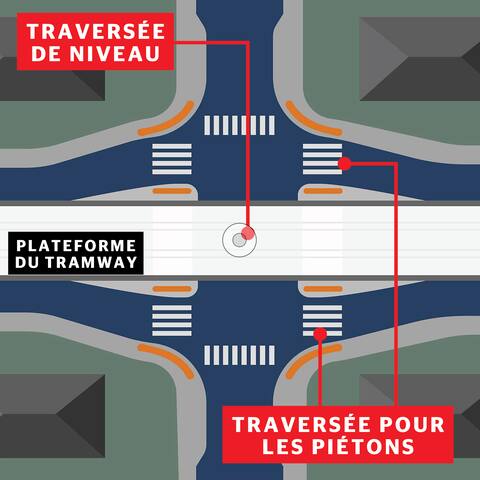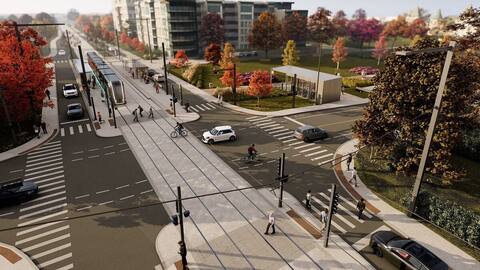Over the next few years, the people of Quebec will have to be patient and adapt because the traffic around the tram platform will be modified twice, during the work and after commissioning, recognizes the City, which promises to give predictability to motorists.
The newspaper met with transport and traffic officials in connection with the tramway project, which will open in 2024 with a view to commissioning in 2029. Martin Côté, coordinator of mobility mitigation measures at the Bureau of the tramway project, and Marc des Rivières, director of the City’s Transportation and Intelligent Mobility Department, explained that the creation of a tramway corridor will “bring about a significant improvement for pedestrians and cyclists, but for motorists, it will require adjustments to habits and routes.
Two planes
Mr. des Rivières points out that there will be two traffic plans: one for the period of the work and another once the tram is running. “There are some conditions that will be similar, but others that will not.”
“The perceived constraints will be greater during the work period than after,” he says.
Mr. Côté adds that the City will indeed try to ensure that people can adapt as soon as the work begins. “When we are going to close a crossing, we will not reopen it afterwards. So, already, the traffic patterns will be integrated by the residents, ”he underlines.
We will also have to completely reorganize parking, especially on René-Lévesque, where the spaces will be removed and redistributed in the neighborhoods.
Communicate in advance
Making everything predictable for as many people as possible will be the “nerve of war”, insists the Project Office, which intends to communicate intensively. In addition, the main arteries on the fringes of the future construction site have all been connected to the arterial manager, which allows traffic management, which will help decongest if necessary.
Safer for pedestrians and cyclists
Among the winners of this new traffic in Quebec, pedestrians and cyclists will see many improvements, argues the Project Office. All along the route, the number of secure sleepers will be multiplied. “Currently, there are 76 places that are signposted, where you can cross. What we plan to do, we just increase it by 57%, to 119”, informs Martin Côté. Pedestrians and cyclists will therefore benefit from traffic lights [pour] pedestrians or signs, with markings on the ground that give them priority in a safe manner. At the crossroads, there will be shelters for walkers. The car lanes will not be linear but rather slightly deviated, to calm the speed.
Infographic City of Quebec and Le Journal
At crossing intersections of the tramway, pedestrian crossings will be set up, with refuge lanes, the tracks will be diverted to slow down traffic and the asphalt will be raised at the level of the platform to allow vehicles to pass.
Firefighters will be able to cross the platform
The tram platform, 15 cm high, is causing a lot of talk and many fear that it “splits the city in two”. The Project Office insists, “It’s not the Berlin Wall.” Made of reinforced concrete, it will be the height of a cell phone. Cars will not be able to cross it at several intersections, in particular to ensure the reliability and commercial speed of the tram, but also to avoid collisions with the tram. But in the event of an emergency, fire engines will be able to cross it, assures Martin Côté. In addition, at intersections where cars can cross the platform, it is the roadway that will be raised to the height of the platform and not the other way around.
Courtesy City of Quebec
With the arrival of the tramway, intersections, such as this one, corner René-Lévesque–Maguire, will be modified to provide safe passages for pedestrians and cyclists. Courtesy City of Quebec
Local traffic plans in seven neighborhoods
On the edge of the route, with the prohibition of left turns in several places, the City will have to carry out “finer” analyzes which it calls “local traffic plans”, both to preserve the tranquility of residents, but also ensure smooth circulation. This is particularly the case of the Henri-IV–Duchesneau quadrilateral, where there is a particular “complexity”, agrees the Project Office, after the exit of the opposition and business people from the sector, who fear the repercussions of the arrival of the tram. The Project Office does not have all the answers to the concerns at this time, but promises meetings and more details in the fall. The other sectors where such plans are in preparation are Pie-XII, boulevard Laurier–Saint-Yves, Saint-Sacrement, Montcalm, Saint-Roch and Vieux-Limoilou–Maizerets.
Adjustments for delivery people, garbage collectors, postal workers and co.
The installation of the tramway platform will change the daily life of several road users, who will have to revise their routes according to the new traffic rules. This will be the case, among others, for truckers, delivery people, Canada Post employees, emergency services and garbage collectors, lists Martin Côté. Waste collection schedules may change. “There could be changes in collection days or times.” More detailed analyzes will be necessary, but the impacts will be “minor”, we are assured. All the users concerned will be notified of the changes well in advance, to give them time to adapt and to avoid unpleasant surprises, insists Mr. Côté.


